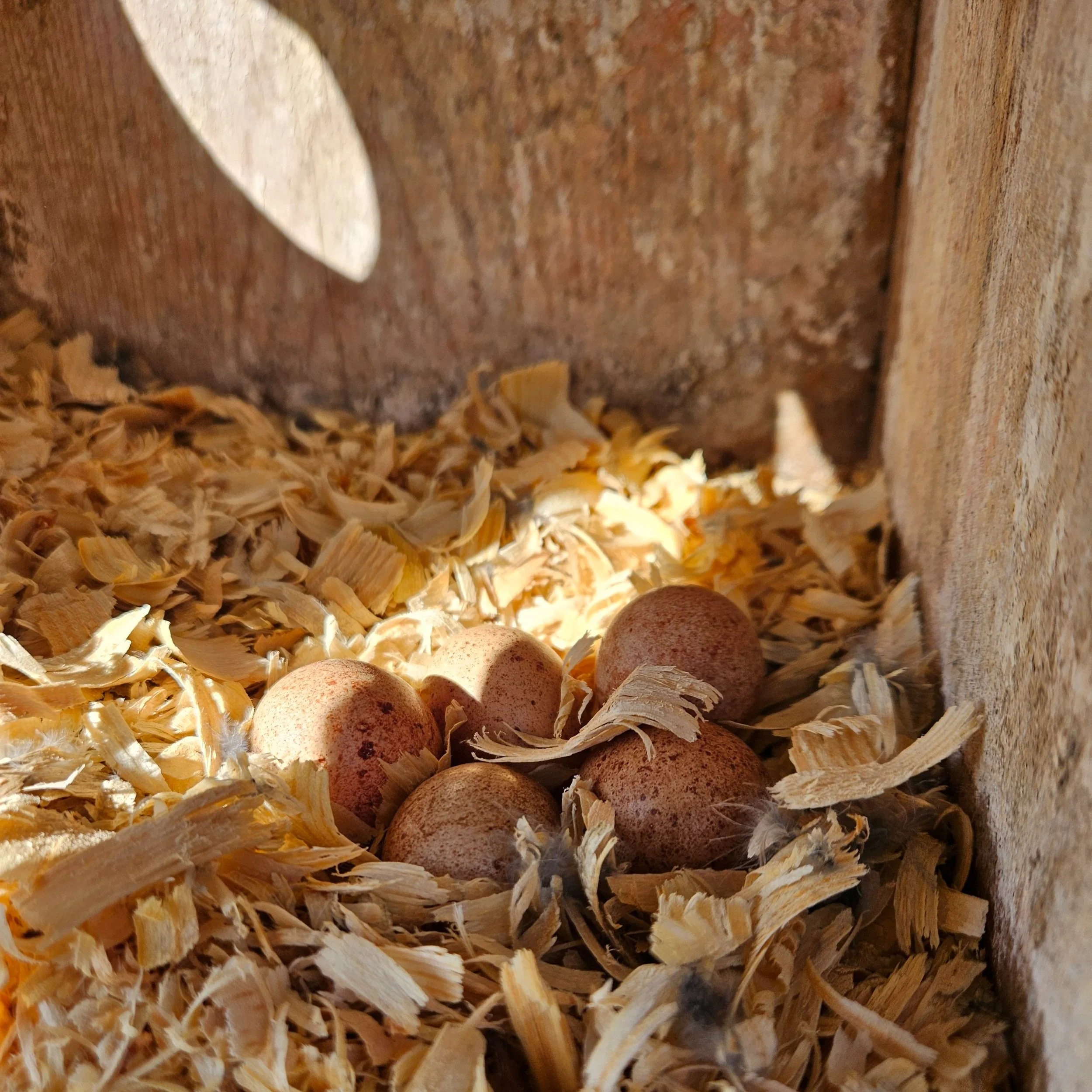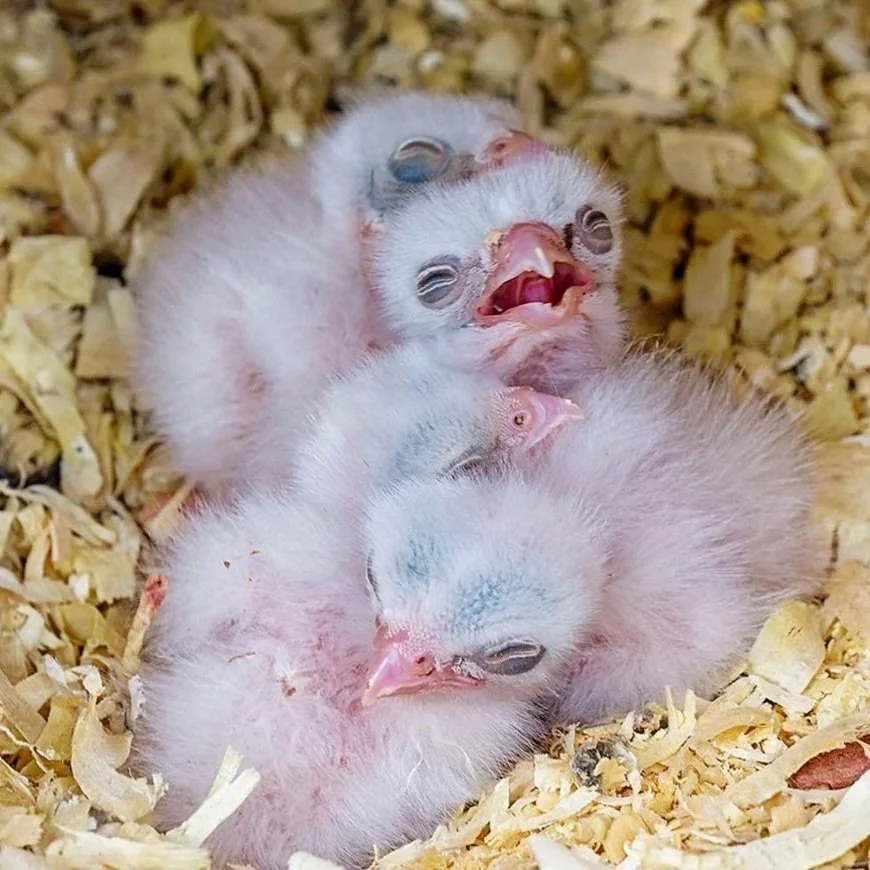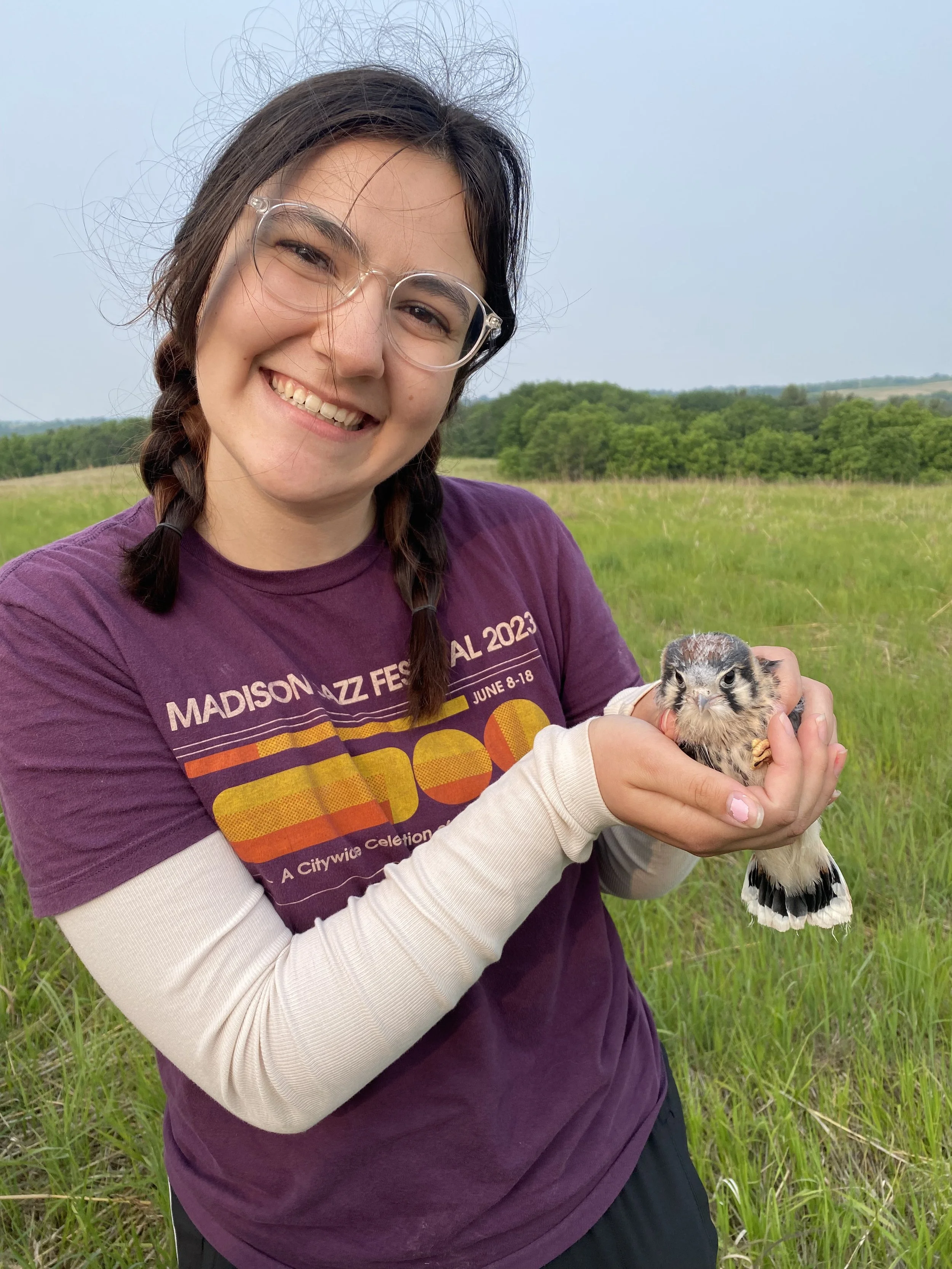A volunteer holds a kestrel chick as it waits to be banded. (Photo by Kaitlin Svabek/SoWBA)
In spring and summer, over a hundred volunteers give their time, energy, gas money, and hearts to American Kestrels. Why? Because this species is beautiful, fierce, and in decline; and the focal point of our citizen science program the Kestrel Nest Box Monitoring & Banding Program (KNB for short). Each year, hundreds of kestrel chicks fledge from the boxes these volunteers steward, and those chicks and some of the adults are banded for research. And each year, we try to get creative about how we can continue to make it easier for kestrels to successfully raise their young in southern Wisconsin.
About kestrels
American Kestrels are North America’s smallest falcon, usually found in rural areas near their preferred habitat: grasslands. They often perch on power lines while they hunt, so keep an eye out for them in spring, summer, and fall as you take road trips! Kestrels also have a cool ability to hover while they hunt, keeping their head almost perfectly still and their eye on the prize as their powerful wings keep them in mid-air.
A kestrel chick was mid-meal when we opened the nest box to band it. She finished up the snake just fine! (Photo by Crystal Sutheimer, June 2025)
Most of their diet consists of insects like grasshoppers and dragonflies, as well as small rodents, birds, amphibians, and snakes. In Wisconsin, kestrels are mostly short-distance migrants, moving south only far enough to find food (in winter, that’s usually rodents and small birds). Some even stick around throughout the winter in southern Wisconsin.
Kestrels are a cavity nester, historically using pre-made holes made by woodpeckers or in dead trees with hollow spots. Dead trees are often removed to reduce safety concerns, and there are fewer natural options for kestrels to nest in. Fortunately, they take readily to man-made nest boxes, which is where our program comes in!
About the program
The KNB program got its official start in 2012, when Brand Smith came on as a volunteer to monitor a dozen or so boxes that were installed years before by Mark Martin and Susan Foote-Martin in the Goose Pond Sanctuary area. Since 2012, Brand has led a consistently successful and expanding program, all on volunteer time and out of a love for this species! In 2025, 111 volunteers monitored 218 kestrel nest boxes in 10 counties.
Before nesting season begins in mid-March, volunteers clean out boxes, add wood chips to the bottom for nesting material and insulation, tighten all the bolts, and make sure the predator guard is secured. Then each week, volunteers visit the nest box, using an endoscope (aka spy cam!) to look into the nest box hole without disturbing the birds. They fill out a form to indicate what species is using the box, if kestrels how many eggs or chicks, how old the chicks are, and more. Then we make a banding plan, and visit each nest box to band the chicks before they fledge.
A clutch of kestrel eggs in a nest box. (Photo by Karin Exo)
Adorable kestrel chicks. (Photo by Phil Brown FCC)
Kestrels typically lay 4-6 eggs, with usually most or all of them hatching. The adults arrange them in a star pattern, and a nest box with a full clutch of light brown, speckled eggs is a beautiful thing indeed. When the chicks hatch after 30 or so days, they’re adorable little fluffballs, and with each passing day growing bigger and stronger with more indicators of age. This is a tricky time for volunteers, who need to estimate the chicks age based on the amount and location of pin feathers and different types of fluff they can see. Fortunately there’s a handy guidebook they use to help determine age. When the chicks are between 14-20 days old, we band, weigh, and measure them, then place them back into the nest box. It’s always fun to watch the adult return to the box within minutes of us leaving the area!
Northern Flicker eggs in a kestrel nest box. (Photo by Julie Beich, KNB volunteer)
There are always other species that use the nest boxes besides kestrels, including Eastern Bluebirds, Northern Flickers, Tree Swallows, House Wrens, Great-crested Flycatchers, and Screech Owls. Though we aren’t aiming to host those species, they’re native and wonderful and we let them do their thing. European Starlings and House Sparrows also try to use these nest boxes, which we work to avoid and deal with.
2025 new and improved
As we do every year, this year we made some interesting adjustments and try new, experimental things in the effort to make such a large program run more smoothly and offer increasing benefits to the birds and the communities around them. We are always working to refine our data collection, management, and analytics, thanks in large part to volunteer Aaron Reinen. It’s a mountain of data, and takes expertise and experience to strike the tricky balance of automating the process and having a human double-check the work.
Raptor perches being installed at Laxey Creek Sheep Ranch in Iowa County in August 2025. (Photo by Juanita Duarte/SoWBA)
New this year, we received a generous grant from the Lafayette County Bluebird Society Legacy Fund to help expand more outreach and kestrel box installation in Lafayette and Iowa Counties, including presentations, a nest box building workshop, supplies for an additional bird bander, and experimental raptor perches installed in the pastures of Laxey Creek Sheep Ranch near Dodgeville. It takes more energy to hunt while in flight, and these perches are intended to offer kestrels (and other raptors) easier access to prey in these open fields. The idea came from the ranch owner, Jeremie, who hails from Switzerland and shared that raptor perches like these are common in that area. Wisconsin Master Naturalist volunteer Samantha Humes constructed the perches.
We also began working with two graduate students who are studying the data we’ve collected over the last 14 years to determine what factors most affect and predict a successful nest. And we are working with two new volunteers who will learn the science and art of banding birds, under the tutelage of our master banders Brand Smith and Kurt Reed.
It’s a lot of work, and takes a lot of time, effort, and heart to make it all happen. A huge thank you goes to all the volunteers who monitor, people who band (Brand Smith, Kurt Reed, and Emma Raasch), folks who do the behind the scenes work, and the property owners we work with to allow us access to the land the boxes are on! It takes a village, and we are so grateful to each and every person involved in the process. Thank you!
Summer intern Juanita Duarte holds a chick that had just been banded in Iowa County. (Photo by Brenna Marsicek/SoWBA)
A kestrel chick is weighed during the banding process in June 2025. (Photo by Brenna Marsicek/SoWBA)
Results of 2025 Kestrel Nest Box Monitoring & Banding Program
Nest Box Monitoring Results
Kestrel nest boxes available: 218
Boxes used by American Kestrels: 69
Nest box occupation rate: 32% (average for our program is 30%)
Successful boxes used by kestrels: 64
Percent nest success rate: 93% (average for our program is 84%)
Number of eggs laid in boxes used by kestrels: 331
Estimated number of kestrel chicks that fledged: 284
Total number of kestrel chicks that have fledged from our boxes since 2012: 2,206!
Kestrel Banding Results
Banding at our nest boxes began in 2016
Number of kestrel chicks banded this year: 266
Total number of kestrel chicks banded from our boxes since 2016: 1,694
Number of adults newly banded this year: 48
Number of adults newly banded from our boxes since 2016: 303
Note: Southern Wisconsin Bird Alliance’s American Kestrel banding program is part of an effort to study an important species over time. All banding, marking, and sampling is conducted under established protocols and under a federally authorized Bird Banding Permit from the USGS Bird Banding Laboratory.
Written by Brenna Marsicek, director of outreach and one of the KNB program coordinators, Southern Wisconsin Bird Alliance











